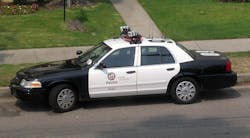Dana Point, CA. “More police officers die of traffic accidents than any other cause,” Los Angeles Police Department (LAPD) assistant commanding officer, Michael C. Williams, said during a presentation at Telogis Latitude today. The LAPD fleet sees some 500 preventable accidents per year among their thousands of patrol cars, according to Williams, a figure he would like to see drop to zero.
In the hope of reaching this goal, the force recently launched a pilot program to access the potential impact on safety of deploying a telematics solution from Ford and Telogis. “The overall level of violence has declined since 1964,” said Williams, a police officer with 38 ½ years of service. “The number of traffic accidents, however, has remained stable or even increased.”For the LAPD, this means not only tragic loss of life and injuries, but also exposure to potentially costly civil liability penalties when civilians are involved in accidents with police vehicles and there is no way to prove how the officer was driving at the time of an incident, he added.
In one instance, officers hit and killed a woman on their way to Venice Beach in response to a call for back-up support, Williams (seen above) recalled. What was the status of the police vehicle at the time of the accident? Were the headlights on? Was the car speeding? Were the red lights and siren on? We could not tell for sure. That’s one thing we hope telematics can show us.
Another obvious thing telematics can do is monitor seatbelt usage among officers so that the data can be used to encourage better use of seatbelts, Williams added. On-the-job seatbelt use among police officers is surprisingly low—only about a 45% compliance rate, he said. The folklore among officers is that you might get “trapped” by your seatbelt in a bad situation, although I can find absolutely no evidence that this has ever happened.
“We have to get our arms around this traffic incident issue,” he said. “The health, safety and care of our officers are just as important as taking care of our community. It is important that we intervene [to do what we can to prevent accidents and injuries].”
We just launched this telematics program, Williams told the audience. “[We still have people who don’t think we can do this; they don’t think we can transform the organization. It will be a challenge].”
Williams, however, has a deployment plan that centers on building collaboration, on giving all stakeholders a place at the table. We need collaboration among union member, managers, mid-level managers and the community, he said. We need to develop benchmarks; utilize telematics to collect performance data; and ultimately create a system that is robust, simple, and user-friendly.
Ultimately, he said, we want to design a dashboard that will show us driver behaviors so that we can intervene before an accident ever happens.
About the Author
Wendy Leavitt
Wendy Leavitt is a former FleetOwner editor who wrote for the publication from 1998 to 2021.

